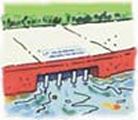The NPDES program controls direct discharges into navigable waters of the United States of America. The State of Florida has been delegated the responsibility of managing the federal requirements of the NPDES program which involves point source discharges (pipes and sewers), and non-point sources (construction sites). NPDES permits, issued by either Environmental Protection Agency (EPA) or an authorized state (such as Florida) contain industry specific, technology-based and/or water-quality-based limits, and establish pollutant monitoring and reporting requirements. A facility that intends to discharge into a water system must obtain a permit before initiating a discharge. A permit applicant must provide quantitative analytical data identifying the types of pollutants present in the facility’s effluent. The permit will then set forth the conditions and sewage limitations under which a facility may make a discharge.
 An NPDES permit may also include discharge limits based on federal or state water quality criteria or standards that were designed to protect designated uses of surface waters, such as supporting aquatic life or recreation. Water quality criteria and standards vary from state to state and site to site, depending on the use classification of the receiving body of water. Most states follow EPA guidelines that propose aquatic life and human health criteria for many of the priority pollutants. The goal is to prevent STORMWATER POLLUTION.
An NPDES permit may also include discharge limits based on federal or state water quality criteria or standards that were designed to protect designated uses of surface waters, such as supporting aquatic life or recreation. Water quality criteria and standards vary from state to state and site to site, depending on the use classification of the receiving body of water. Most states follow EPA guidelines that propose aquatic life and human health criteria for many of the priority pollutants. The goal is to prevent STORMWATER POLLUTION.
WHAT IS STORMWATER POLLUTION?
Stormwater pollution is urban runoff water that has picked up pollutants as it flows through the storm drain system- a network of channels, gutters and pipes that collect runoff from city streets, neighborhoods, farms, construction sites and parking lotsand empties directly into local waterways. Unlike sewage, which goes to treatment plants, urban runoff flows untreated through the storm drain system. Anything thrown, swept or poured into the street, gutter or a catch basin (the curbside openings that lead into the storm drain system) can flow directly into our channels, creeks, bays and ocean. This includes pollutants like trash, pet waste, cigarette butts, motor oil, anti-freeze, runoff from pesticides and fertilizers, construction debris, paint from brushes and containers rinsed in the gutter and toxic household chemicals.
HOW DOES STORMWATER POLLUTION AFFECT OUR RESIDENTS AND BUSINESSES? Contaminated urban runoff is an uncontrolled nonpoint source of pollution into local waters, and may contribute to beach closures. Litter, leaves and other debris clog catch basins, which cause flooding when it rains. Flooding can damage property (cars, buildings and equipment), create health hazards (fleas, mosquitoes and bacteria) and hurt the City’s image as a desirable place to live and work. It is illegal for businesses without a permit to discharge wastewater or other materials into the storm drain system.
You can report illegal storm drain discharge by calling 954-519-1499.






